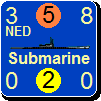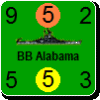Shannon V. OKeets
Posts: 22095
Joined: 5/19/2005
From: Honolulu, Hawaii
Status: offline

|
quote:
ORIGINAL: palad1n
After looking at the mods folder and downloading the KiF mod, I come to realise that the new aircraft will probably not appear with a correct bmp image as each bmp image (in the pages bmps and associated text files) relates to the existing aircraft sequential numbers in the csv file. So, more work is required in that space. I have discovered that one cannot simply reference a previous number, as in a 981 Ju 87D Stuka is a single entity and a 982 Ju 87D Stuka, if changed to 981, does not work at all. At least the default solution by MWiF is to use the "flipped side" aircraft profile. I would be interested to hear why this singular approach was adopted in lieu of a one bmp image fits all instances of the same aircraft (type, model, etc) This would have saved some memory and somewhat future proofed MWiF. Notwithstanding, I'll be working to add to the unit bmp files so the AiF and PATiF aircraft units have the appropriate bmp image. I do hope (trust) that MWiF can accept pages 23+. For further details go to the mods thread. On a positive note, the naval side is OK as TRSs, AMPHs and SUBs have a generic "face up" bmp profile. I am also changing the whole air CSV file to have every instance of a particular aircraft type (model, etc) to be exactly the same. Further, and perhaps Shannon can answer this one, the 5th column (or col E if loaded as a spreadsheet) appears to be completely superfluous - only a few are populated with +name+name (for example). I have deleted all contents of this column and there appears to be no issues; could I assume that it had a potential purpose originally but was overtaken by future developments (similarly for same column for naval csv) - while on naval csv file, is there a purpose for columns 15 and 16 (spreadsheet columns O & P) repeating the same value (CV aircraft capacity)? As I said, further developments will be posted in the mods thread.
The abbreviated name field (column 5) for the Air Units is used for long names so the names do not run into/over the numeric factors. If the abbreviated name field is blank, then the program assumes there isn't going to be a problem. When the unit has an abbreviated name, then the name is split into two lines (top and bottom) and the vertical centering changes from 1 line to 2 lines. The placement of air unit names depends on the unit type and its nationality. The use of periods and commas in the names were different historically (e.g., German versus Italian). I know next to nothing about this and relied completely on Patrice Forno to tell me how these should be handled. The program parses the names based on the punctuation. If I were creating new units, I would look for an existing one of the same unit type and nationality, and mimic how the name for the existing one was encoded.
The naval units (carriers) probably have duplicate entries for Air Class and Air Capacity (columns 15 and 16). These files were originally generated from the CWIF binary data files. CWIF read in binary files that depended on Delphi Object definitions. I converted all the data to ASCII so they could be read using database/spreadsheet/text editor software. To do that, I wrote some code to generate the ASCII files after the CWIF code had read in the binary data. Later I modified to MWIF read in the ASCII data (and never used the CWIF data files again). At that time CWIF had the two data fields - it took me several months before I could convince myself that the data fields were identical. But notice that I still said 'probably' in the first sentence of this paragraph.
_____________________________
Steve
Perfection is an elusive goal.
|
 Printable Version
Printable Version
















 New Messages
New Messages No New Messages
No New Messages Hot Topic w/ New Messages
Hot Topic w/ New Messages Hot Topic w/o New Messages
Hot Topic w/o New Messages Locked w/ New Messages
Locked w/ New Messages Locked w/o New Messages
Locked w/o New Messages Post New Thread
Post New Thread